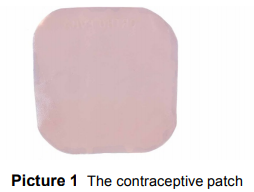Birth Control: Contraceptive Patch

The contraceptive patch (Picture 1) is a birth control that looks like a small bandage. The patch contains estrogen and progestin. These are like the hormones made naturally in your body. The patch prevents pregnancy by stopping the egg from being released from the ovary. The patch also changes cervical mucus to keep sperm from reaching an egg.
Advantages of the Patch
- 91% effective against pregnancy with typical use
- Menstrual periods stay regular
- Can decrease menstrual cramps
- May improve premenstrual syndrome (PMS)
- Can improve acne
- Can decrease risk of uterine and ovarian cancer
Disadvantages of the Patch
- Possible side effects include: breast tenderness, nausea, irregular bleeding, headaches, and irritation or rash at the patch site. Many of these symptoms improve with time.
- The patch may interact with certain antibiotics, anti-seizure, and HIV medicines.
- The patch may not work as well for people who weigh more than 198 lbs.
How to Use It
- Place the patch directly onto your skin. It can go on one of these places: on the upper arm, shoulder, upper back, abdomen, hip, or buttock. One patch lasts for 1 week. After 1 week, take off the old patch, and then put a new one onto a different spot on your body. You do this once a week for 3 weeks. The 4th week you do not wear a patch, and you have your period.
- Change your patch on time every week. This is very important.
- If your patch falls off within 24 hours of being applied, try to reapply the patch if it is still sticky. If not, replace it with a new patch.
If You Are Late Changing Your Patch
- If it is less than 48 hours since you were supposed to have changed the patch or it has been off, apply a new patch as soon as possible. Change the patch the same day you had planned to at first.
- If it has been more than 48 hours since you were supposed to have changed the patch (or you are not sure how long it has been off), apply a new patch as soon as possible and use backup contraception for 1 week. Call your health care provider.
- If you do not want to become pregnant, consider using emergency contraception (EC) if you are late changing you patch at all. DO NOT use ulipristal acetate (Ella®) for EC. It can make the patch not work.
Risks With the Patch
- Blood clots: Increased risk of stroke or heart attack. Blood clots can develop in veins (deep vein thrombosis) and in the lungs (pulmonary embolism). These conditions are rare, but can be life‐threatening.
- High blood pressure: Possible small increase in blood pressure. For most people, this increase is small and does not affect one’s health.
- Nicotine products (vape pens, cigarettes, or chewing tobacco): These products can increase your risk for heart attack and stroke. This risk increases as you get older.
Who Cannot Use It
Do not use the patch if you have:
- High blood pressure
- Severe liver disease
- Blood clotting disorder
- Some type of migraine headaches
- History of blood clot(s), stroke, or heart disease
- Had a baby within the past month and are breastfeeding
Tell your doctor or health care provider if you have any of these risk factors or conditions, or any other medical concerns.
When to Call 911
Call 911 or go to the nearest emergency room if any of the following occurs:
- Unusual pain or swelling in the legs
- Unusual pain in your chest
- Severe headache
- Trouble breathing or speaking
- Sudden change in vision
- Weakness or numbness
When to Call the Health Care Provider
Call the doctor or healthcare provider if you:
- Think you are pregnant
- Think you might have a sexually transmitted infection (STI)
- Have depression or change in mood
- Have new or worse headaches
- Miss a period or are late in starting your period
Preventing STIs
The patch does not protect against sexually transmitted infections (STIs). Condoms are the best way for sexually active people to reduce the risk of infection. Always use a condom when you have sex. Get yearly health check-ups, including testing for STIs.
HH-IV-191 2/22 Copyright 2022, Nationwide Children’s Hospital
